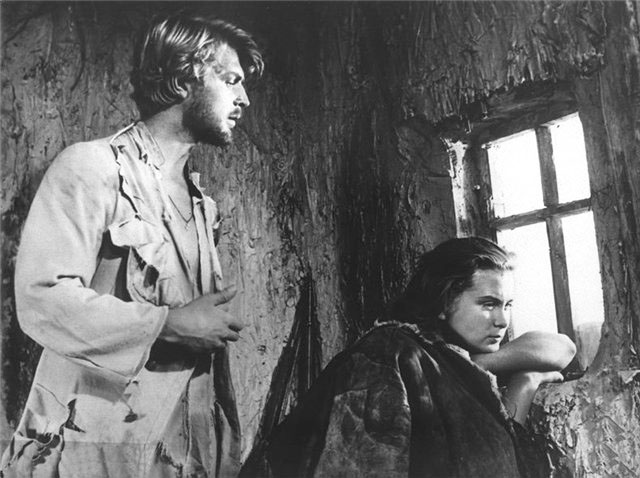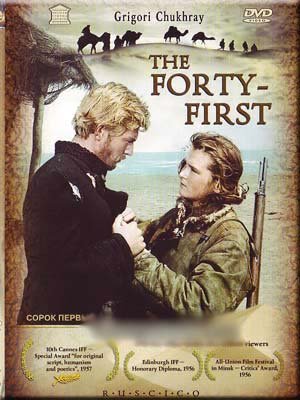
After the death of Soviet premier Joseph Stalin in 1953, Russia began to experience a less repressive period in the arts, especially the cinema, which had previously been used for mostly propaganda purposes. During this brief period, which flourished between 1953 and 1967, Russian filmmakers were allowed to explore the artistic possibilities of the medium, resulting in a number of cinematic masterpieces which enjoyed international distribution, even in the U.S. Among the more famous of examples from the “Cinema of the Thaw” (as it came to be called) are Sorok Pervyy (The Forty-First, 1956), Letyat Zhuravli (The Cranes are Flying, 1956), the historical epic, Tikhiy Don (And Quiet Flows the Don (1957), Don Kikhot (Don Quixote, 1957), The Idiot (1958), based on the novel by Fyodor Dostoevsky, and Ballada o Soldate (Ballad of a Soldier, 1959). The latter film, in particular, which won a special award for director Grigori Chukhrai at the Cannes Film Festival, is still considered a high water mark for Soviet cinema in the 50s but it is Chukhrai’s debut film, The Forty-First, which launched the director’s career and is in danger of being forgotten.
A remake of the popular 1927 version, which was based on a novel by Boris Lavrenyou, Chukhai’s version did not overtly emphasize the political aspects of the story and choose instead to concentrate on the human drama at its center. Set in 1919, The Forty-First opens as a battalion of 23 Red Army soldiers are forced to retreat into the Karakum Desert (somewhere between Kazakhstan and Uzbekistan) after suffering a defeat by White Army forces. Despite their desperate circumstances, they manage to capture a courier for the czarist regime, Lt. Vadim Nikolayevich Govorkha Otrok (Oleg Strizhenov), who possesses top secret information for White Army officials. Commissar Yevsukov (Nikolay Kryuchkov), who is leading the Red Army survivors, decides not to shoot Lt. Otrok on the spot but to escort him to Bolshevik headquarters where he will be tortured until he reveals his information and then killed.

Yevsukov entrusts his most valuable soldier, Maryutkh (Izolda Izvitskaya), with keeping watch over their hostage and she is the perfect choice since she is a sharpshooter who has already killed forty men with her rifle. Maryutkh is unhappy with her assignment and has nothing but contempt for her educated, upper-class prisoner. Yet, as the situation grows more dire and her comrades begins to die off from hunger, thirst and exhaustion as they cross the desert toward the Aral Sea, Maryutkh has to rely on her hostage for help in surviving the trek. A mutual trust and respect eventually develops between the prisoner and jailer which gives way to a forbidden romance once the pair become shipwrecked on a deserted island in the Aral Sea.

The Forty-First is a fascinating and compelling mixture of genres that combines a war drama with a tale of survival and a tender love story. The first half of the film is appropriately grim and brutal as the ragtag Red Army survivors are subjected to sand storms and the extreme temperatures of the desert with freezing nights and sunscorched days. In some ways this portion of the film shares some similarities in setting and physical endurance to John Ford’s The Lost Patrol (1934), The Flight of the Phoenix (1965) and even Lawrence of Arabia (1962), with cinematographer Sergey Urusevskiy’s color-muted depiction of the desert as something both beautiful and otherworldly but also deadly.

The film’s transition to a love story in the second half of The Forty-First is all the more effective after such a harrowing beginning and the romance offers a brief escape from the realities of war. Maryutkh slowly sheds her fierce revolutionary façade and reveals a fondness for composing simplistic agitprop poetry with Nikolayevich aiding her creative efforts through his own literary expertise. The scene where he stimulates Maryutkh’s imagination by telling her the story of Robinson Crusoe is both touching and schmaltzy, much like the scene in Elia Kazan’s Viva Zapata! (1952) in where Josefa (Jean Peters) teaches the Mexican revolutionary (Marlon Brando) to read on their wedding night.

Some film critics have complained that the central romance of The Forty-First is overly poetic and sentimental with its luminous close-ups of the two soulful looking lovers but it still works on the level of a romantic fantasy that is doomed from the start. We know from the title, which refers to the number of kills Maryutkh has accomplished with her rifle, that this story won’t end well. But that doesn’t prevent The Forty-First from being both moving and tragic in its final moments.

Director Chukhrai would go on to much greater acclaim for his follow-up feature Ballad of a Soldier while his cinematographer on The Forty-First – Sergey Urusevskiy – would become world renowned for his stunning work on three key films by Mikhail Kalatozov, The Cranes Are Flying, Letter Never Sent (1960) and I Am Cuba (1964).
The significance of The Forty-First is largely forgotten today but its importance during the “Cinema of the Thaw” is best expressed by Georges Sadoul in Dictionary of Films: “Chukhrai’s remake of the classic story…came at the end of an era when it had been heresy to show a Red in love with a White, or to show the White as anything but a fiend. Chukhrai found that the story – which also portrayed sexual love, another taboo subject at the time – allowed him to return to the source of the best Soviet cinema. Chukhrai used the romantic story to portray the hopelessness and misery that war inevitably brings. Its sincerity and superb photography…brought this version a success that marked a turning point in Soviet Cinema.” The film is also an easily accessible entry point for moviegoers who want to sample some classics of Soviet cinema but aren’t sure where to begin.

The Forty-First is not currently available on any format in the U.S. but you might be able to find an import version on DVD from online sellers. A better option is to view a fine digital restoration of the film from the MOSFILM Cinema Concern with English subtitles on Youtube.
Other links of interest:
https://golden.com/wiki/Grigory_Chukhray-K4E5YB
https://www.jewage.org/wiki/he/Article:Grigori_Chukhrai_-_biography
https://timenote.info/en/Izolda-Izvitskaya
https://www.independent.co.uk/news/people/obituary-nikolai-kryuchkov-1371355.html



